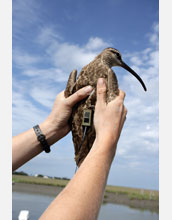Multimedia Gallery
Migrating Whimbrels Track Thousands of Miles
A whimbrel, a type of shorebird, displays its new solar transmitter that will allow scientists to track its migration, even through hurricanes.
More About This Image
A consortium of ornithologists from the College of William & Mary tracked four whimbrels from their arctic breeding grounds to South America and the Caribbean, where they winter over. The birds' southbound migration, which includes miles of open ocean, takes place during hurricane season. The researchers found that all four of the tracked birds--named Chinquapin, Goshen, Hope and Machi by the researchers--successfully migrated through or around Hurricane Irene and Tropical Storm Maria during their flight.
Whimbrels use the marshes and tidal creeks of the Eastern Shore as staging areas for their trips in both directions, resting before continuing their journey. However, the researchers found that rather than make this stop, Chinquapin flew a direct route, leaving upper Hudson Bay on Aug. 20. He flew right into Irene's northeast quadrant--then a category 3 with 110 mile-per-hour winds--on Aug. 24, but satellite signals showed he arrived safely on the Bahamian Island of Eleuthera days later. He garnered much publicity for this feat, with a write-up in USA Today and a feature by Diane Sawyer on ABC News.
Goshen also encountered Irene, but only the outer bands of the storm. The other two birds--Hope and Machi--chose to wait the storm out on the Eastern Shore, hunkering down while nearly a foot of rain fell upon them before finishing their trip. Sadly, while Goshen was strong enough to tangle with Hurricane Irene and Machi strong enough to cross thousands of miles, the two birds were no match for human prey. Each was gunned down within hours of their arrival on the Caribbean Island of Guadeloupe. Sport gunning is legal on many Caribbean islands, where there are no agreements to protect birds such as the Migratory Bird Treaty Act of 1918. While there is no official count of how many birds are killed annually, Bryan Watts, director of the Center for Conservation Biology at William & Mary, points out the fact that Goshen and Machi were killed within hours of their arrival, suggesting that the hunting pressure on the islands is enormous. (Date of Image: August 2011)
Credit: Bart Paxton, Center for Conservation Biology, William & Mary/VCU
Images and other media in the National Science Foundation Multimedia Gallery are available for use in print and electronic material by NSF employees, members of the media, university staff, teachers and the general public. All media in the gallery are intended for personal, educational and nonprofit/non-commercial use only.
Images credited to the National Science Foundation, a federal agency, are in the public domain. The images were created by employees of the United States Government as part of their official duties or prepared by contractors as "works for hire" for NSF. You may freely use NSF-credited images and, at your discretion, credit NSF with a "Courtesy: National Science Foundation" notation.
Additional information about general usage can be found in Conditions.
Also Available:
Download the high-resolution JPG version of the image. (960 KB)
Use your mouse to right-click (Mac users may need to Ctrl-click) the link above and choose the option that will save the file or target to your computer.

